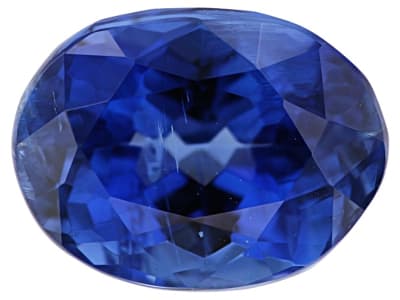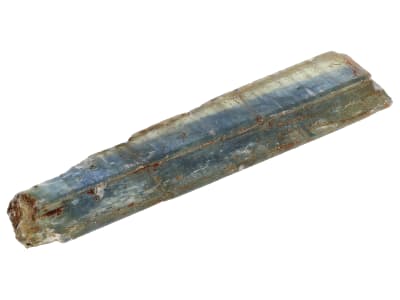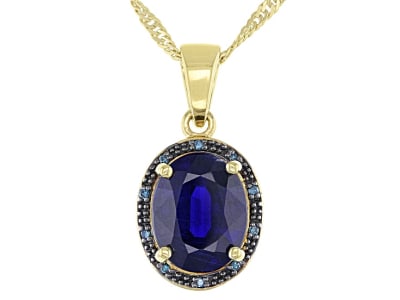Kyanite was better known as a mineral specimen, or for industrial use, until the rich blue variety of gemstone was found in Nepal in the late 1990’s. The orange stones from Tanzania hit the market in the mid 2000’s. Teal chromium and mint green stones were found in Orissa, India in 2013 and 2014. Kyanite is a major challenge to lapidaries due to its perfect cleavage and hardness. The stone has also been called disthene for the Greek words meaning "two" and "strong". This is because the hardness of Kyanite is different depending on what direction it is being tested. It has a 4.5 mohs hardness parallel to its long axis. The mohs hardness can exceed 7 when scratched perpendicular to the long axis. Kyanite is frequently color zoned.
General Information
LWUV: Weak red
Kyanite Colors
-
 Blue
Blue -
 Blue
Blue -
 Blue
Blue -
 Brown
Brown -
 Gray
Gray -
 Green
Green -
 Green
Green -
 Green
Green -
 Orange
Orange -
 Orange
Orange -
 Pink
Pink -
 White
White -
 Yellow
Yellow
Kyanite Spectra
We acknowledge the significant scientific contributions of John S Harris, FGA to the study of gemstone spectra and with deep appreciation to him, acknowledges the use of his images and related notes about gemstones and their spectra in the educational materials on this website.
Alternate Names
Cyanite Or Disthene
Countries of Origin
Sudan; Kazakhstan; Portugal; Greece; Austria; Mongolia; Korea (the Republic of); Morocco; Unknown; Brazil; Slovenia; Nepal; Colombia; Ecuador; Argentina; Hungary; Japan; Ukraine; Zambia; Mauritius; Bolivia (Plurinational State of); India; New Zealand; Canada; Turkey; Namibia; Finland; Italy; South Africa; Antarctica; Ethiopia; Germany; Tanzania, United Republic Of; Macedonia (the former Yugoslav Republic of); Afghanistan; Russian Federation; Viet Nam; Czechia; United States of America; Egypt; Somalia; Madagascar; United Kingdom of Great Britain and Northern Ireland; Netherlands; Sweden; Pakistan; China; Ireland; Poland; Slovakia; Bulgaria; France; Romania; Sri Lanka; Kenya; Switzerland; Spain; Cuba; Liberia; Bangladesh; Burkina Faso; Norway; Botswana; Zimbabwe; Suriname; Israel; Australia; Greenland; Tajikistan
History
The kyanite name comes from the Greek word, kyanos, which means "blue". The bright, cornflower-like color transforms an ordinary piece of jewelry into a statement-making display. Although the earliest kyanite on the market was primarily blue, discoveries of green and orange material have expanded color choices in this gemstone. Kyanite has a hardness from 4 ½ - 7 on the Mohs scale and has perfect cleavage. For the lapidary (stone cutter), this poses a real challenge. Kyanite has a 4 ½ to 5 mohs hardness parallel to its long axis and 6-7 perpendicular to the long axis. Kyanite has heat resistant properties and most of kyanite that is mined for industrial use. Kyanite is used in bricks, casting molds and porcelain used as insulators and bathroom fixtures.
Care
Be mindful of cleaning and storing this lovely stone. Avoid ultra-sonic cleaners. A dip in warm, sudsy water and a soft brush will keep your kyanite looking its best. Carefully store kyanite when you aren't wearing it.
More About Kyanite
It's believed by some people that kyanite calms the mind and spirit and brings tranquility. For an intensely blue stone, that certainly makes sense, since blue is thought to be a calming color. It's also believed that kyanite doesn't hold negativity. Instead, it aligns all chakras, is said to provide balance, and stimulates self-expression. Many find it to be a fine meditation stone. The folkloric attributes of kyanite are not supported by science. We can't affirm anything about the mind and spirit, but we think you'll enjoy your kyanite for its tranquil, blue color.



